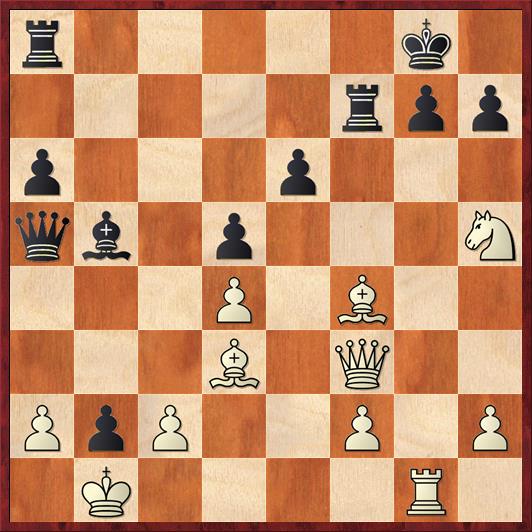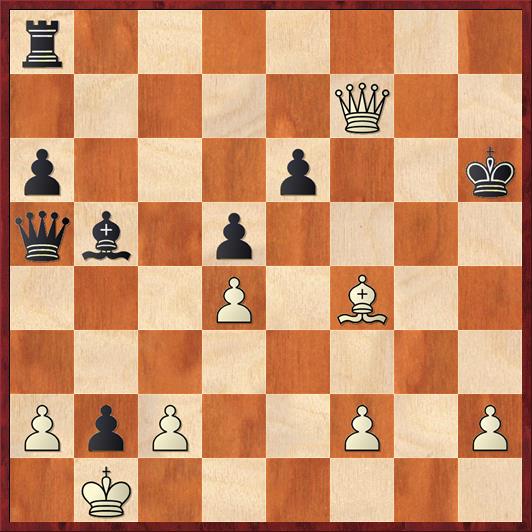This title sounds like the beginning of a joke: The best way to beat a grandmaster… is ANY WAY YOU CAN. (This is spoken by somebody who has never done it.)
Nevertheless, if I ever beat a GM, I would want to do it the way that IM Eric Rosen did today. At the Xtracon Chess Open in Denmark, he was paired against GM Simen Agdestein, former trainer of Magnus Carlsen. As somebody said on Facebook, “Good job for showing us why that guy is Carlsen’s former coach haha.”
As White, Rosen played a nice aggressive variation in the London System, with a TN already on move 7 and queenside castling on move 9. Agdestein, to put it bluntly, overreacted. He thought he could punish Rosen directly and sacrificed a piece. But according to the computer it wasn’t sound. In fact, Rosen kept a cool head, gave back some of the material and was very much in control after that.
Eventually they reached the position below, where it’s White to play and win.
 Position after 24. … Bb5. White to move.
Position after 24. … Bb5. White to move.
FEN: r5k1/5rpp/p3p3/qb1p3N/3P1B2/3B1Q2/PpP2P1P/1K4R1 w – – 0 25
White has two sacrifices that both look tempting: Bxh7+ or Nxg7. Which one should he play?
It’s a trick question, because they are both good and in fact White should play them both, one after the other. Nevertheless, I think that Rosen picked the most precise move order.
25. Nxg7! …
Here White’s threats are so overwhelming that Stockfish evaluated the position at +95.95 for White! Rybka is a little bit more conservative, and puts White’s advantage at “merely” 12.25 pawns. (But probably that advantage would grow if it went a few more ply.)
The reason for these extravagant evaluations is that both Stockfish and Rybka see that the only way Black can keep from getting mated is to give up his queen outright with 25. … Qe1+. I think we can all agree that if that is Black’s best move, he might as well just resign.
If Black doesn’t want to resign, the two most consequential variations are the one in the game and 25. … Bxd3, where Black at least tries to reduce the number of White attackers. After 25. … Bxd3 White has only one correct move, but it’s not hard to find: 26. Nf5+, which not only creates a discovered check but also blocks the Black bishop from interposing on g6. After 26. … Kf8 27. Bh6+ Ke8 28. Nd6+, basically the roof collapses on Black. 29. Qxf7+ will follow, and Black’s king cannot find shelter.
Black’s other option is the one he actually played: 25. … Rxg7, after which White has a mate in five. If you didn’t work it out in the initial position, see if you can find it now.
The answer is 26. Rxg7+ Kxg7 27. Be5+ Kg8 28. Bxh7+! The second piece sacrifice leaves Black’s king completely bare of defenders. Agdestein resigned here, as there is no alternative to 28. … Kxh7 29. Qf7+ Kh6 30. Bf4 mate.
FEN: r7/5Q2/p3p2k/qb1p4/3P1B2/8/PpP2P1P/1K6 b – – 0 30
For beginners, this mate pattern with the queen and bishop is very thematic and important to learn. The Black king is caught in a 3-by-4 box with the queen and bishop at the corners. I have a feeling, although I can’t prove it, that this mating pattern is one of the least well-known of the “pure” checkmates (where White mates with just two pieces against Black’s bare king).
I should also point out that this was Rosen’s second win in a row over a grandmaster, and it placed him in a seven-way tie for first place at 5½-½. Take a look at the players he is tied with! (Listed in order of rating):
- GM Baadur Jobava 2714
- GM Nigel Short 2688
- GMKrishnan Sasikiran 2688
- GM Marin Bosiocic 2616
- GM Daniele Vocaturo 2592
- GM Frode Urkedal 2543
- IM Eric Rosen 2369
There are four more rounds in the tournament, so plenty of time yet for Rosen’s Cinderella tournament to turn into a pumpkin… But we can at least hope that his enchanted run will continue!
By the way, I didn’t know anything about Rosen before today. He is a Facebook friend of a friend of mine, which is how I found out about this game. He is a 24-year-old student at Webster University, played for the Webster Windmills in the PRO Chess League, and you can find his webpage and a not very active blog here.




{ 1 comment… read it below or add one }
Dana – Just a quick note about that concluding queen-and-bishop mate pattern.
When analyzing 25. Nxg7, I visualized the game ending slightly differently than it did: 25. … Rxg7 26. Rxg7+ Kxg7 27. Be5+ Kg8 28. Bxh7+ Kxh7, and now 29. Qh5+ Kg8 30. Qg6+ Kf8 31. Bd6 mate – the exact same mate pattern, reflected symmetrically across the long diagonal.
One of those little aesthetic moments that make chess so pleasing!
Regards,
Dave Gertler
(vanquisher of 2 GMs, loser to dozens)